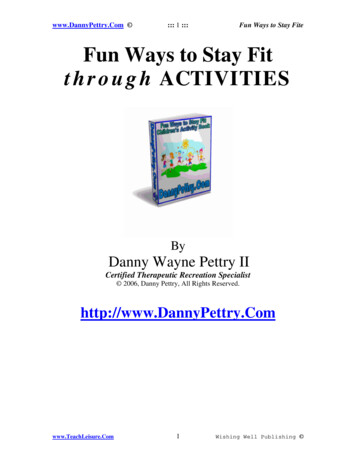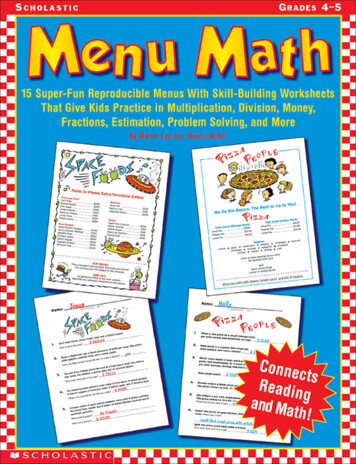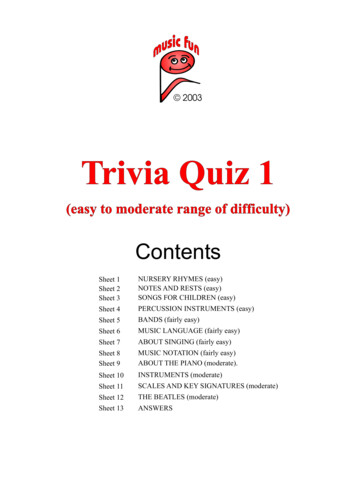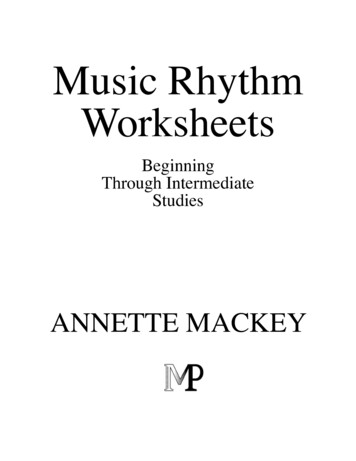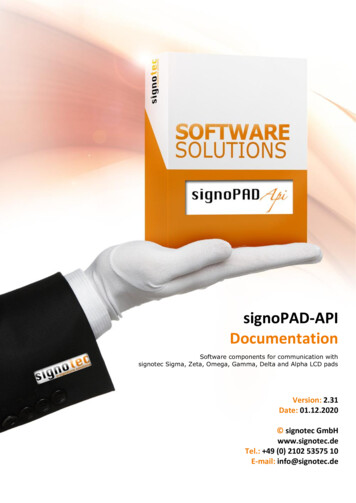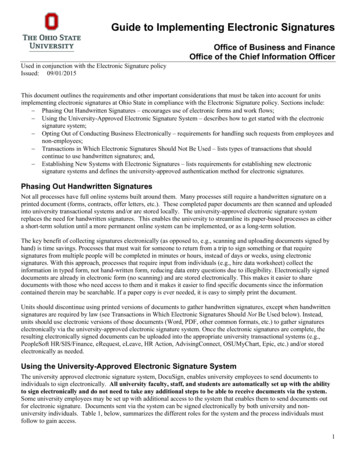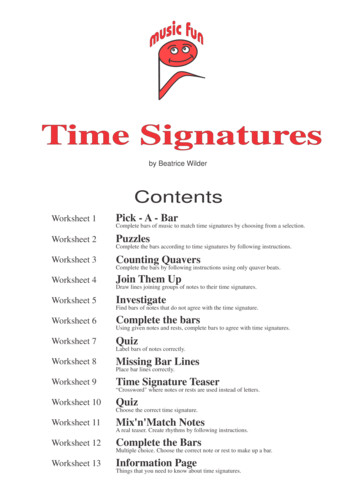
Transcription
Time Signaturesby Beatrice WilderContentsWorksheet 1Pick - A - BarComplete bars of music to match time signatures by choosing from a selection.Worksheet 2PuzzlesComplete the bars according to time signatures by following instructions.Worksheet 3Counting QuaversComplete the bars by following instructions using only quaver beats.Worksheet 4Worksheet 5Join Them UpDraw lines joining groups of notes to their time signatures.InvestigateFind bars of notes that do not agree with the time signature.Worksheet 6Complete the barsUsing given notes and rests, complete bars to agree with time signatures.Worksheet 7QuizLabel bars of notes correctly.Worksheet 8Missing Bar LinesPlace bar lines correctly.Worksheet 9Time Signature Teaser“Crossword" where notes or rests are used instead of letters.Worksheet 10QuizChoose the correct time signature.Worksheet 11Mix'n'Match NotesA real teaser. Create rhythms by following instructions.Worksheet 12Complete the BarsMultiple choice. Choose the correct note or rest to make up a bar.Worksheet 13Information PageThings that you need to know about time signatures.
Copyright Beatrice Wilder 1997Published in 1997 by Music FunP.O. Box 342 Katoomba NSW 278019 Millyard Lane Katoomba 2780Phone: (02) 4782 3073Email: info@musicfun.com.auWeb: www.musicfun.com.au
Pick - A - BarComplete the bars of music by choosing notes and rests from the boxes in the middle of the page.Draw a line through each box of notes and rests as you use it. You may use each box only once.Time SignaturesWorksheet 1Name .
Name .Time SignaturesWorksheet 2PUZZLESComplete the bars - following the instructions1.7.Add one note and two rests.Choose a time signature:2.8.Add a bar line.A whole bar of silence. Add a rest.3.9.Complete the time signature.Complete this bar using rests only.4.10.Choose a time signature:or5.Add three notes.11.Add six quavers, correctly grouped.6.Add two notes and two rests.12.Complete this bar using rests only.Complete this bar with just one note.
Name .Time SignaturesWorksheet 3Counting QuaversInstead of counting quarter note or crotchet beats,we are counting eighth note or quaver beats. Each quaver is one beat. 1. 7.Add one rest.2.Add a dot.8.Add two notes grouped together.3.Add a time signature.9.Make this a whole bar of silence.4.Add rests.10.Add two notes.5.Add four notes.11.Use just one note and one rest.6.Complete the time signature.12.Add a time signature.Join these notes in the correct way.
Name .Time SignaturesWorksheet 4Join Them UpDraw lines joining the bars of notesto their correct time signatures.?
Time SignaturesWorksheet 5Name .InvestigateLook carefully at these bars of notes!In each set there is one bar that does not agree with the time signature.Find all the incorrect bars and draw a cross through them.1.2.3.4.5.6.7.8.
Time SignaturesWorksheet 6Name .Complete the BarsSet 6.Set 5.Set 4.Set 3.Set 2.Set 1.Use only the symbols supplied at the beginning of each setand use each symbol only once.
Time SignaturesWorksheet 7Choose from:Name .QUIZAdd time signatures andlabel these bars correctly.Simple (undotted)Compound (dotted)Simple Duple - Simple Triple - Simple Quadruple (two, three or four beats in each bar)Compound Duple - Compound Triple (two or three dotted note beats in each bar)
Time SignaturesWorksheet 8Name .Missing Bar LinesLook carefully at the time signatures anddraw the bar lines in their proper places.1.2.3.4.5.6.7.8.
Name .Simple Triple.Two identical longernotes, followed bytwo identical shorternotes.Simple Quadruple.First two notes areidentical. The rest are ofsmaller value, also identical.Note, rest, note, rest.Three quaver beats in a bar.5.6.8.9.8Includes three notesof the same value,one of a smallervalue and a rest.11.Across107The first note is a long note.11. Simple Triple time.second and third noteshave the same value.10. Simple Duple. The6242.1.Two identical short notesfollowed by two identicallonger notes.First note is worthone beat.Down119539. Three beats in a bar.There are two rests.7. Simple triple.6. Compound Duple.Note, note, rest, note.4. Simple Duple.note is the same as the last.Two other notes are identical.3. Four beats in a bar. The firstComplete this puzzle using only notes. One note or rest per square. Each ‘word’ is a bar of notes and rests.Time Signature TeaserTime SignaturesWorksheet 9
Time SignaturesWorksheet 10Name .QUIZTick the correct time signaturesChoose the correct time signature for each bar of music. Tick the box next to it.
Time SignaturesWorksheet 11Name .Mix and MatchCreate your own rhythms. Watch the time signatures!Draw bar lines in the correct places.1.Use all the above notes and rests. Add a crotchet rest. Draw bar lines in the correct places.2.3.4.Using the above notes and rests, remove one group of two quavers and add a semibreve at the end.Draw bar lines.Plan this one carefully! Rearrange the notes above but remove a whole note and a crotchet rest.Add a dot to the crotchet and the crotchet rest. Add two quaver rests. Draw bar linesUse the notes above and add a group of three quavers and a dotted crotchet. Draw bar lines.5.6.Use the above notes but remove one quaver, all the dots and quaver rests and add two half notes and asemibreve. Draw bar lines.
Time SignaturesWorksheet 12Name .Complete the BarsChoose the notes or rests to complete these bars.Draw a line through the ones you don’t need.
Time SignaturesWorksheet 13Name .Information PageThis time signature is called SIMPLE DUPLE.Simple because the beats that we are counting are made of plain, undotted notes.Duple because there are two beats to count.The top number is 2 which tells you that there are two beats in each bar.The bottom number is 4, which tells you that you are counting crotchets, or quarter notes.This time signature is called SIMPLE TRIPLE.Simple because the beats that we are counting are made of plain, undotted notes.Triple because there are three beats to count.The top number is 3 which tells you that there are three beats in each bar.The bottom number is 4, which tells you that you are counting crotchets, or quarter notes.This time signature is called SIMPLE QUADRUPLE.Simple because the beats that we are counting are made of plain, undotted notes.Quadruple because there are four beats to count.The top number is 4 which tells you that there are four beats in each bar.The bottom number is 4, which tells you that you are counting crotchets, or quarter notes.This time signature is called SIMPLE TRIPLE.Simple because the beats that we are counting are made of plain, undotted notes.Triple because there are three beats to count.The top number is 3 which tells you that there are three beats in each bar.The bottom number is 8, which tells you that you are counting quavers, or eighth notes.This time signature is called COMPOUND DUPLE.Compound because the beats that we are counting are made of dotted notes.Duple because we are really only counting two beats.The top number is 6 which tells you that there are six pulses in each bar.The bottom number is 8, which tells you that you are counting quavers, or eighth notes.Notice that the BEATS are made of dotted crotchets, and there are only two in each bar.The PULSES are made of quavers, and there are six of those.One dotted crotchet has the same value as three quavers.
Note, rest, note, rest. Simple triple. There are two rests. Simple Duple. The second and third notes have the same value. First note is worth one beat. Three quaver beats in a bar. Three beats in a bar. Simple T riple time. The first note is a long note. T wo identical short notes followed by two identical longer notes. T ime Signatur es W .


